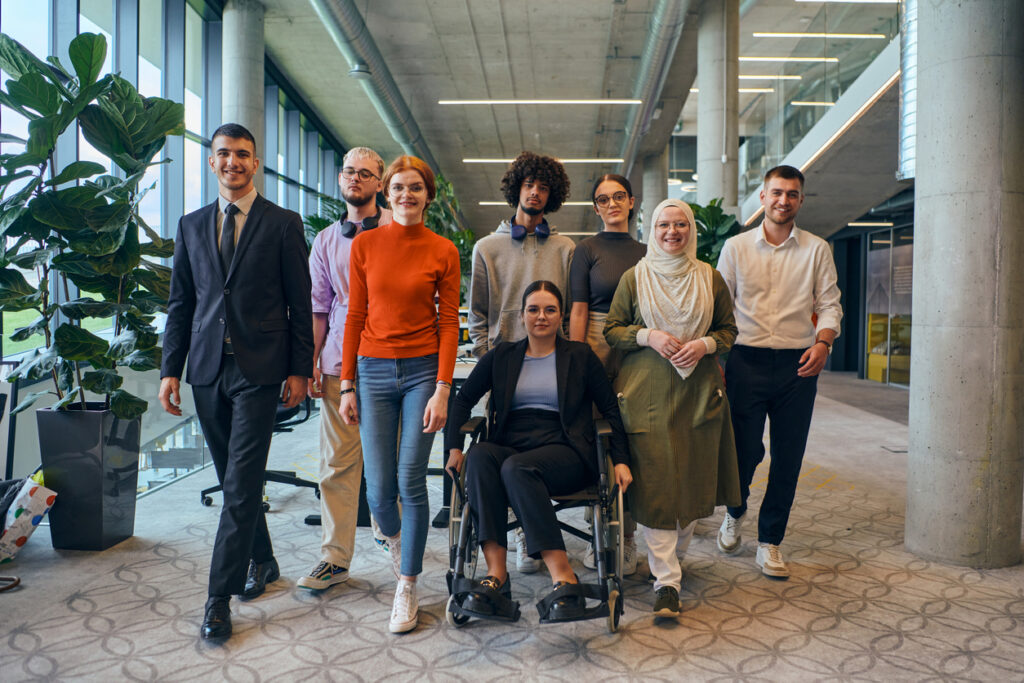
Everyone’s talking about diversity and inclusion. But who’s actually measuring it? And how?
For many organisations, diversity is part of the mission statement. Inclusion is a value on the wall. But when it comes to understanding how those values show up in everyday work, especially in meetings, decisions, and culture, it’s often guesswork.
We all want to build workplaces that are fair, inclusive, and empowering. But that’s hard to do without real data.
Diversity and inclusion (D&I) aren’t just HR goals, they’re the foundation of better outcomes for people and performance. From innovation and productivity to wellbeing and retention, D&I supports every part of your business.
So how do you know if your workplace is actually inclusive?
Simple. You measure it.
What Is Diversity?
Let’s begin with a clear definition.
Diversity is about representation. It refers to the mix of people in your organisation — across race, gender, age, ability, sexual orientation, neurodiversity, culture, language, education, and more.
It also includes diversity of experience, perspective, and thinking. A team with a broad range of backgrounds brings more ideas to the table and sees problems from different angles.
But diversity isn’t just about who you hire. It’s about ensuring that a wide variety of people are in decision-making processes, across all parts of the business.
Diversity asks: Who’s being included? Who’s being left out?
What Is Inclusion?
Inclusion is what happens after people are in the room.
It’s about how people are treated, valued, and supported once they’re part of a team. Do they feel safe to speak up with a different or unique perspective? Are they encouraged to contribute? Are their ideas taken seriously? Do they feel like they belong?
Inclusion is the experience of being respected, heard, and recognised — no matter your background.
Diversity without inclusion is a revolving door. People might join your organisation, but if they don’t feel safe or seen, they won’t stay. Or, even if they stay, they are unlikely to put in discretionary effort or go above and beyond their job description.
Inclusion asks: How do people feel here? Do they feel they matter?
Why Is Diversity and Inclusion Important in the Workplace?
When diversity and inclusion go hand-in-hand, the outcomes are undeniable. Here’s what happens when organisations invest in D&I:
1. Team engagement and decision making
Inclusive leadership was found to be highly correlated to higher levels of Organisational Citizenship Behaviour, that is, going above and beyond (Raiz et al., 2023) and proactive work behaviour (Rogozińska-Pawełczyk & Sudolska, 2024).
Teams that are diverse and inclusive make better decisions 87% of the time (Cloverpop, 2017). That’s because they draw from more perspectives and challenge each other’s thinking.
2. Team Performance
Team performance was found to be highly correlated to inclusive leadership (Jiang, 2020). Inclusive teams reach decisions twice as fast with half as many meetings, thanks to smoother collaboration and reduced friction (Cloverpop, 2017).
3. Higher innovation
Inclusive leadership was found to be highly correlated to greater levels of innovation (Al Munthiri et al., 2024). Inclusive companies are 1.7 times more likely to be innovation leaders in their industries (Bersin, 2015). (Al Munthiri et al., 2024)
Different voices drive creative thinking and problem-solving.
4. Improved employee wellbeing
When people feel included, they’re more engaged and motivated. Inclusion supports mental health, boosts morale, and builds a sense of purpose. Inclusive leadership was found to be highly correlated to job satisfaction (Roberge et al., 2021) and to self-esteem (Kuknor & Bhattacharya, 2021).
5. Stronger talent retention
Inclusive leadership is highly correlated to employee intentions to stay (Kim et al., 2024) According to Randstad (2018), 78% of employees say that working in an equitable and respectful environment is a key factor in whether they stay at a job.
Diversity and inclusion aren’t just about what’s “right”. They’re about what works.

The Gap Between Intention and Action
Most companies believe in diversity. Many are actively trying to improve inclusion. But very few are actually measuring it in a meaningful way.
Here’s the problem: if you’re not tracking something, you can’t improve it. And without measurement, it’s nearly impossible to know what’s working and what’s not.
This creates a disconnect:
- We say we care about inclusion, but we don’t track inclusive behaviour.
- We run training, but don’t check if it’s changing anything.
- We set goals, but don’t know if we’re getting closer.
That’s why measurement matters.
Why Measure Diversity and Inclusion?
1. Because what gets measured, gets improved
You can’t improve workplace inclusion by guessing. You need real feedback from real people, on real experiences.
Data makes patterns visible. It tells you where your strengths are and where you’re falling short. When you track inclusion, you can start to shift it intentionally.
2. Because inclusion lives in everyday moments
Inclusion doesn’t just happen during onboarding or performance reviews. It shows up in how people speak in meetings, how decisions are made, who’s invited, and who gets heard.
That’s why we focus on meetings, because they’re where culture happens in real time.
3. Because everyone has a role to play
Inclusion shouldn’t just sit with HR or a leadership committee. When individuals can see and reflect on their own habits and contributions, they’re more likely to make meaningful changes.
That’s why we built the Gender Fitness App — to put inclusion into people’s hands, one meeting at a time.
How to Measure Diversity and Inclusion in the Workplace
There are a few common ways organisations can measure D&I:
A. Quantitative data
- Demographic breakdowns across levels, departments, and roles
- Pay equity analysis
- Promotion and retention stats by identity group
B. Qualitative insights
- Employee experience surveys
- Feedback from focus groups or 1:1 interviews
- Inclusion or engagement pulse checks
C. Behavioural measurement
- Meeting participation
- Decision-making involvement
- Peer feedback on inclusivity
This third category, behavioural measurement, is where many organisations fall short. That’s where Gender Fitness comes in.
A New Way to Track Inclusion: Introducing Gender Fitness
Gender Fitness is an app that helps teams track inclusivity in their meetings. It connects to your calendar and makes it easy for attendees to give anonymous feedback on the inclusivity and gender balance of any meeting.
No big forms. No complicated dashboards. Just quick, regular feedback that helps build awareness and create change.
Key features include:
- Calendar integration – Meetings are automatically imported
- Anonymous scoring – Feedback is never tied to names
- Real-time insights – Teams see their average scores and trends
- Organisation-wide comparisons – See how you stack up
- Accessible anytime – Works across devices, day or night
- Secure and private – Built for trust and ease of use
Why Start With Meetings?
Because meetings are where inclusion shows up — or doesn’t.
They’re where decisions happen. Where people share ideas. Where others stay quiet. Where culture becomes visible. By starting with meetings, you get real, daily insights that reflect how your workplace actually operates, not just how it looks on paper.
Meetings are where people feel heard — or left out.
And when you make meetings more inclusive, the effects ripple outward. You start seeing changes in collaboration, engagement, confidence, and team dynamics.

Empowering People, Not Just Processes
One of the biggest barriers to D&I progress is that it often feels like someone else’s job. It’s a policy. A program. A thing “the business” is working on.
But inclusion becomes powerful when everyone feels they can contribute.
Gender Fitness puts the power to improve inclusion into people’s everyday routines, without adding more meetings, admin, or complexity. It’s simple enough to use consistently, but powerful enough to spark real cultural change.
Real Progress, One Day at a Time
We believe that the biggest changes come from the smallest shifts done regularly, with intention.
- Giving someone space to speak
- Not interrupting
- Noticing who’s always quiet and checking in
- Reviewing who’s invited to the meeting — and who’s not
These things matter and they add up.
With Gender Fitness, teams start to notice these patterns and act on them. Over time, meetings get more balanced. Voices are more evenly heard. People feel more respected. And your culture begins to shift, from the inside out.
Inclusion Can’t Wait
We’re long past the point of asking if diversity and inclusion are important. The question now is: What are we doing about it? And is it working?
If you’re not measuring inclusion, you’re guessing. And in today’s fast-moving world, that’s not good enough.
When you track D&I, you empower people. You spark better conversations. You build trust. And you unlock performance, innovation, and wellbeing — not just for a few, but for everyone.
Because when everyone has a seat at the table and a voice in the room, great things happen.
Want to start measuring your organisation’s inclusivity?
If you’re ready to start measuring how inclusive your organisation truly is, the Gender Fitness App can show you where your meetings stand and where they can improve. Book a demo today or get in touch to learn more about how Gender Fitness can help you build a more inclusive and effective workplace.
References Cited
- AlMunthiri, O., Bani Melhem, S., Mohd Shamsudin, F., & Al-Naqbi, S. A. (2024). Does leading with inclusiveness promote innovative behaviours? Examining the role of work engagement and psychological safety. International Journal of Organizational Analysis.
- Jiang, Z. (2020). Research on the impact of inclusive leadership on team knowledge sharing—a multi-level model test with two-dimensional identity as the mediator. Academic Journal of Engineering and Technology Science, 3(7), 23–36.
- Kim, H., Shin, Y. H., & Severt, K. (2024). Inclusive Leadership and Positive Outcomes Through Hotel Employees’ Perceptions of Inclusion. International Journal of Hospitality & Tourism Administration, 1–21. https://doi.org/10.1080/15256480.2024.2377151
- Kuknor, S., & Bhattacharya, S. (2021). Organizational inclusion and leadership in times of global crisis. Australas. Account. Bus. Finance J., 15(1 Special Issue), 93–112. https://doi.org/10.14453/aabfj.v15i1.7
- Raiz, A. G., Ishaque, A., Abbasi, M., & Khan, F. (2023). Impact of inclusive leadership on project citizenship behavior: A mediation-moderation mechanism of psychological empowerment and trust in leadership. Journal of Positive School Psychology, 771–792.
- Roberge, M.-É., Wen-Rou, H., & Qiumei Jane, X. (2021). A Diverse and Inclusive Psychological Work Climate: Some Antecedents and Consequences. Journal of Organizational Psychology, 21(6), 162–185. https://doi.org/10.33423/jop.v21i6.4839
- Rogozińska-Pawełczyk, A., & Sudolska, A. (2024). Exploring the impact of inclusive leadership on proactive work behavior in nonprofit organization: The mediating role of the relational psychological contract. Nonprofit Manage. Leadership. https://doi.org/10.1002/nml.21619
